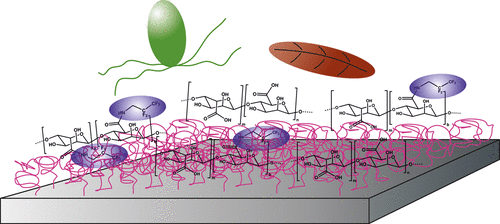当前位置:
X-MOL 学术
›
Biomacromolecules
›
论文详情
Our official English website, www.x-mol.net, welcomes your feedback! (Note: you will need to create a separate account there.)
Amphiphilic Alginates for Marine Antifouling Applications
Biomacromolecules ( IF 6.2 ) Pub Date : 2018-01-16 00:00:00 , DOI: 10.1021/acs.biomac.7b01498 Victoria Jakobi 1 , Jana Schwarze 1 , John A. Finlay 2 , Kim A. Nolte 1 , Stephan Spöllmann 3 , Hans-Werner Becker 3 , Anthony S. Clare 2 , Axel Rosenhahn 1
Biomacromolecules ( IF 6.2 ) Pub Date : 2018-01-16 00:00:00 , DOI: 10.1021/acs.biomac.7b01498 Victoria Jakobi 1 , Jana Schwarze 1 , John A. Finlay 2 , Kim A. Nolte 1 , Stephan Spöllmann 3 , Hans-Werner Becker 3 , Anthony S. Clare 2 , Axel Rosenhahn 1
Affiliation

|
Amphiphilic polymers are promising candidates for novel fouling-release coatings for marine applications. We grafted amphiphilic alginates with fluorinated side chains to glass and silicon substrates and characterized the obtained films by contact angle goniometry, spectroscopic ellipsometry, XPS, and ATR-FTIR. The potential to inhibit protein attachment was tested against four different proteins, and intermediate fluorine loadings showed the strongest reduction with respect to hydrophobic, aliphatic controls. A similar trend was observed in dynamic attachment experiments using Navicula perminuta diatoms and settlement experiments with zoospores of the green algae Ulva linza. The results indicate that amphiphilic alginates are promising natural and renewable biomacromolecules that could be included in future protective coating technologies.
中文翻译:

用于海洋防污应用的两亲藻酸盐
两亲性聚合物是船舶应用新型污垢释放涂料的有前途的候选者。我们将带有氟化侧链的两亲藻酸盐接枝到玻璃和硅基板上,并通过接触角测角法,椭圆偏振光谱法,XPS和ATR-FTIR对获得的膜进行了表征。测试了针对四种不同蛋白质的抑制蛋白质附着的潜力,并且相对于疏水性脂肪族对照,中等氟含量显示出最强的降低。在使用Navicula perminuta硅藻的动态附着实验和使用绿藻Ulva linza游动孢子的沉降实验中观察到了类似的趋势。结果表明,两亲性藻酸盐是有前途的天然和可再生生物大分子,可以包含在未来的保护性涂层技术中。
更新日期:2018-01-16
中文翻译:

用于海洋防污应用的两亲藻酸盐
两亲性聚合物是船舶应用新型污垢释放涂料的有前途的候选者。我们将带有氟化侧链的两亲藻酸盐接枝到玻璃和硅基板上,并通过接触角测角法,椭圆偏振光谱法,XPS和ATR-FTIR对获得的膜进行了表征。测试了针对四种不同蛋白质的抑制蛋白质附着的潜力,并且相对于疏水性脂肪族对照,中等氟含量显示出最强的降低。在使用Navicula perminuta硅藻的动态附着实验和使用绿藻Ulva linza游动孢子的沉降实验中观察到了类似的趋势。结果表明,两亲性藻酸盐是有前途的天然和可再生生物大分子,可以包含在未来的保护性涂层技术中。



























 京公网安备 11010802027423号
京公网安备 11010802027423号